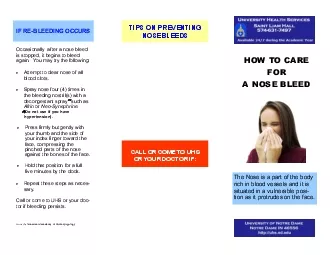

IF REOccasionally after a nose bleed is stopped it begins to bleed again You may try the followingAttempt to clear nose of all blood clotsSpray nose four 4 times in the bleeding nostrils with a dec ID: 874655
Download Pdf The PPT/PDF document "BLEEDING OCCURS" is the property of its rightful owner. Permission is granted to download and print the materials on this web site for personal, non-commercial use only, and to display it on your personal computer provided you do not modify the materials and that you retain all copyright notices contained in the materials. By downloading content from our website, you accept the terms of this agreement.
1 IF RE - BLEEDING OCCURS Occasionally
IF RE - BLEEDING OCCURS Occasionally after a nose bleed is stopped, it begins to bleed again. You may try the following: Attempt to clear nose of all blood clots. Spray nose four (4) times in the bleeding nostril(s) with a decongestant spray * such as Afrin or Neo - Synephrine . * (Do not use if you have hypertension). Press firmly but gently with your thumb and the side of your index finger toward the face, compressing the pinched parts of the nose against the bones of the face. Hold that position for a full five minutes by the clock. Repeat these steps as neces- sary. Call or come to UHS or your doc- tor if bleeding persists. from the American Academy of Otolaryngology HOW TO CARE FOR A NOSE BLEED TIPS ON PREVENTING NOSEBLEEDS CALL OR COME TO UHS OR YOUR DOCTOR IF: The Nose is a part of the body rich in blood vessels and it is situated in a vulnerable posi- tion as it protrudes on the face. If you or a friend has an anterior nosebleed, you may be able to care for it yourself using the follow- ing steps: FIRST : Help the patient stay calm , especially a young child/person. A person who is agitated may bleed more profusely than someone who’s been reassured and supported. NEXT : 1. Pinch all the soft parts of the nose together be- tween your thumb and t he side of your index finger. Or 2. Soak a cotton ball with Afrin. Ne- oSynephrine, or Dura - Vent spray and place this into the nostril. 3. Press firmly but gently with your thumb and the side of your index finger toward the face, compressing the pinched parts of the nose against the bones of the face. 4. Hold that position for a full five minutes by the clock. 5. Keep head higher than the level of the heart. Sit up or lie back slightly with the head elevated. 6. Apply crushed ice in a plastic bag or washcloth to nose and cheeks. HOW TO STOP A NOSEBLEED TREATMENT FOR NOSEBLEEDS Many physicians suggest any of the following lu- bricating creams or ointments. They can be pur- chased without a prescription: Bacitracin Eucerin Polysporin Triple Antibiotic Vaseline Up to three (3) applications a day may be needed, but usua
2 lly every night at bedtime is enough.
lly every night at bedtime is enough. A saline nasal spray will also moisten dry nasal membranes. Use a humidifier during dry winter months. Recurring nosebleeds can also be caused by: Blowing or picking the nose. Strain or bend down to lift anything heavy. Have your head down lower than you heart. A nosebleed that recurs 4 times or more in a week needs medical evaluation to deter- mine the seriousness of the problem. Nosebleeds that recurs 2 to 3 times in a month may mean that a chronic condition such as allergies is causing the nosebleeds. When nosebleeds cannot be con- trolled by home treatment, you need an evaluation by your health profes- sional. ANTERIOR NOSEBLEEDS Most nosebleeds begin in the lower part of the septum, the semi - rigid wall that separates the two nostrils of the nose. The septum contains blood vessels that can be broken by a blow to the nose or the edge of a sharp fingernail. This type of nosebleed comes from the front of the nose and begins with a flow of blood out one nostril when the patient is sitting or standing. Anterior nosebleeds are common in dry climates or during the winter months when heated, dry indoor air dehydrates the nasal membranes. Dry- ness may result in crusting, cracking, and bleed- ing. This can be prevented if you place a bit of lubricating cream or ointment about the size of a pea on the end of your fingertip and then rub it inside the nose, especially on the middle portion of the nose (septum). CAUSES OF NOSEBLEEDS A hot dry indoor climate — This is a trigger for nosebleeds in parts of the United States where heat (especially forced - air - heat) is used during the winter months. Changes in the sea- sons is also a factor. Allergies or Infections , that causes itching and lead to picking of the nose. Vigorous nose blowing that ruptures superfi- cial bleed vessels in the elderly and in the young. Fractures of the nose or of the base of the skull that can cause bleeding and should be regarded seriously when the bleeding follows a head injury. Medications which prevent normal blood clotting, (i.e. Coumadin, aspirin or any anti - inflammatory medication). Abnormal growths or tumors, particularly in the older patient or in smokers. RECURRING NOSEBLEED